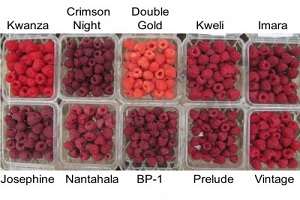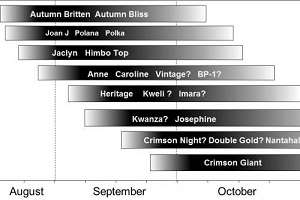By Eric Hanson
Fall-fruiting or primocane fruiting raspberries produce in late summer and fall on the current year primocanes. They differ from floricane fruiting types that produce berries on the second year canes in the middle of summer. Primocane fruiting types are popular because they can be pruned inexpensively, but fruit also ripen late in the season when spotted wing Drosophila populations are high. If you are growing these varieties, be prepared to manage these flies that can infest the fruit.

There are numerous older primocane fruiting varieties and many new types to choose from. We have been able to assess these types in southern Michigan with funding through the NIFA Specialty Crop Research Initiative (TunnelBerries). Here is a summary of variety choices for Michigan and the upper Midwest.
Harvest times
Choose varieties that ripen early enough to pick high yields for your region. Earlier maturing types are best for short growing season locals, and early and later maturing types are suitable for areas with longer growing seasons. The chart below provides general harvest times for primocane fruit in southern Michigan. Move the bars to the right in more northern locations.

Early types
Polka and Joan J are the two that have performed best for us. Both are high yielding with excellent quality. Polka has bright red, glossy fruit that are firm and tasty. Joan J also has excellent flavor and firmness, but fruit are a darker red. Joan J canes are thornless.
Himbo Top is a little later maturing but extremely productive and easy to pick. Berries are large and lighter red, but have an average flavor and are less firm, so they may not pack and ship as well. Jaclyn has very flavorful, firm berries, but is not grown widely because yields are modest and berries are darker.